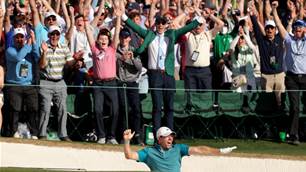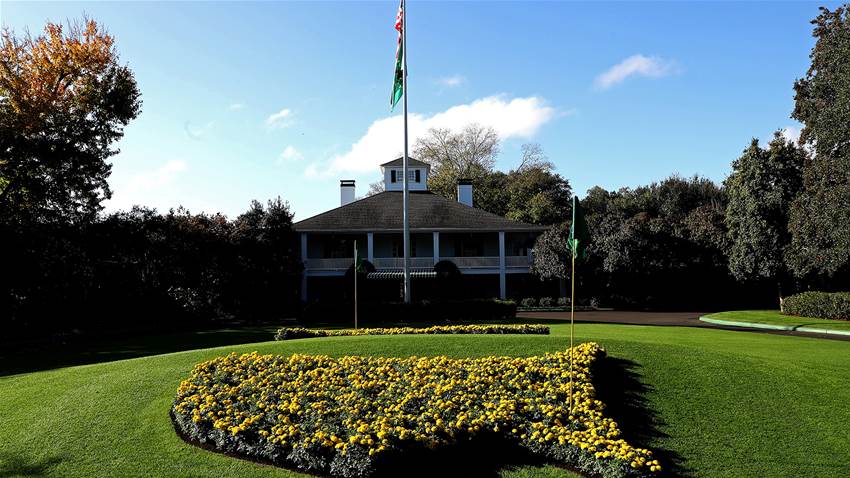More than three decades have passed since my first visit to Augusta National Golf Club. The first of Nick Faldo’s three victories in 1989 was my maiden Masters. And yes, I was excited.
As soon as I arrived, I was off round the course, taking in the less familiar front-nine before making my way through the iconic back-nine. It was quite a thrill.
Since that far-off day, I’ve been back more than 20 times, lucky enough to cover that many ‘toonamints’ for a variety of magazines and newspapers. It’s been a lot of fun. Not perfect, though. Nothing is, of course. And the Masters is no exception.
Yes, there are aspects of the event that are hard to fault. But equally, there are things that continue to perplex, which is odd, at a place where the attention to detail – the more cynical might label that “pedantry” – is second-to-none.
Anyway, for what it’s worth, here is one man’s two-sided view of the various ingredients that go together to make the youngest of the four major championships. Yes, the Masters is an outstanding student. But in certain areas it still has some growing up to do.
Positive: IT’S THE MASTERS
There is no denying the feeling of awe just about any golfer experiences when viewing the course and the tournament. First time out, there is no sense of let-down. So, there is no denying the fact that, at least initially, the Masters lives up to the “everything is perfect” image billing it works so hard to project. So yes, it really is a wonderful place to be. Especially if you like the colour green.

Negative: I DON’T FOLLOW
This has always confounded me. At the Masters, running is strictly forbidden. But the officials seem to have a problem with walking too. While there are some great spots on the course from which to watch the action as it passes by – Amen Corner and the 16th green come immediately to mind – for those wishing to walk all 18-holes with a particular player, the “service’ is way less satisfying.
In fact, it is just about impossible to do that and see every shot struck by your favourite. At ANGC, bottlenecks abound, a situation exacerbated by the unwillingness of the marshals (no doubt under orders from above) to apply even a modicum of common-sense to the ‘fairway crossing’ policy in place.
Many times, spectators stand behind a rope for multiple minutes as players stroll as much as 100-yards before crossing the crossing. By that time, the guy you are following is somewhere in the middle distance – and at least one shot further into his round than he was when you left him. Frustrating and annoying.
 Positive: PRICE OF FOOD/DRINK
Positive: PRICE OF FOOD/DRINK
This has always impressed me. Maybe because they already have more money than they know what to do with, the green jackets do a great job with the cost of just about everything in the beautifully organised and neatly unobtrusive concession stands.
Everything from drinks to candy bars to sandwiches is – and here’s a word you hardly ever hear at ANGC – cheap. Which is to the credit of the club, no matter the motivation. They could, after all, charge at least double and no one would complain.
Negative: EMPTY CHAIRS
In a tradition reminiscent of German holidaymakers laying towels in advantageous spots next to swimming pools, Masters ‘patrons’ are allowed to ‘book’ their places on the course by leaving (personalised) chairs early each morning. Sometimes, those seats lie empty for hours on end, depriving others of the opportunity to take a pew and view the action from a position of comfort.
This practise is obviously unfair. And unjustifiable.

Positive: AMEN TO AMEN CORNER
There are a few places in the world every golfer yearns to experience. The 1st tee and the 18th green on the Old Course at St. Andrews are two of those. Just about anywhere at Cypress Point is another. You could easily pay a similar tribute to Royal Melbourne. Sunningdale in England is one of my particular favourites. As is Morfontaine in France.
But I digress.
Many words have been written about how special Amen Corner is. But none have really done the place justice. That would be impossible. Standing near the 12th tee is a once-in-a-lifetime thing every time, if that makes sense. Gazing back up the 11th fairway. Peering across to the distant 12th green and 13th tee. Watching the drives land on 13. It is, in short, golf-geek heaven.

Negative: GET IN LINE, AGAIN AND AGAIN
The Masters logo is a beautiful thing, one of the most recognisable in all of sports. And surely one of the most lucrative if the queue to enter the Masters merchandise ‘shop’ is anything to go by. Which is my point.
Although this financial goldmine is bigger than it used to be, it remains clearly unfit for purpose. A trip to spend money can take anything up to an hour of your Masters day, the serpentine line outside just the beginning.
Inside things don’t really get any better. The floor space is jam-packed with customers jockeying for an opportunity to boost the ANGC coffers. No place for claustrophobics. Then there is the inevitable queue at check-out. All in all, the whole thing is a thoroughly unenjoyable experience.
Positive: IN THE SHADE BUT OUT IN THE OPEN
It isn’t Cheers, the Boston bar where everybody knew your name, but under the massive oak tree that sits between the Augusta National clubhouse and the 1st tee comes close. Just about anyone who is anyone – plus the media – gets together under the branches to meet, greet and gossip during the Masters. It’s the place to get things done, the place to catch up on what is going on – and what isn’t.
One caveat. It is a roped off area, of course. The public are free to gawk at, but not gather with, the chosen few. Which pretty much sums up the club really. Egalitarian it is not.

Negative: A DISTANT VIEW
I mentioned the bottlenecks earlier. Well, the worst aspect of those is that they are, by definition, crowded. The 7th green is one of the worst examples. Good luck trying to get a decent view of the action around that putting surface. At best, you get glimpses over the heads and shoulders of the four-deep rows already in place. A comfortable and/or satisfying experience it is not, one repeated at more than a few others. The solution? More grandstands required.
Positive: BEST HOLE IN WORLD?
Take my word for this. The 13th at Augusta National might just be the best hole in the world. Or, at least it was at one time. But even today, when what Bobby Jones called the “momentous decision” is too often absent from the second shot to the distant green that sits just beyond a tributary of Rae’s Creek, this par-four-and-a-half retains enough of its strategic joy. It is Alister MacKenzie’s masterpiece, an accolade for which there is much competition.

Negative: 16TH GREEN
It’s been a while now, but when three-time Masters champion Nick Faldo told me that the severely sloping green on this par-3 should be “blown up,” it was hard to disagree. And that conclusion remains true today.
It is on this hole that the Masters comes closest to living down to the “Mickey Mouse” accusations you often hear from players in private. In the manner of the 17th green at TPC Sawgrass, this green represents the sort of “dumbed-down” golf that appeals to the casual fan but makes the more-savvy viewer shudder.
Nowhere is that contrast more in evidence than on the final day of the Masters. Player after player hits his tee-shot into the green’s right-to-left slope and watches as the ball filters down towards the cup. Louder and louder are the roars as the ball nears its ultimate target. Louder and louder are the internal groans of those who prefer to see ‘proper golf.’
Positive: STRATEGY LIVES ON, BUT ONLY JUST
It isn’t quite what it was as blasting away from the tee has become more and more advantageous in the modern game, but intelligent strategy remains a factor in the Masters.
Modelled by MacKenzie and Jones on the Old Course at St. Andrews, the original thinking behind the course is still apparent, albeit less than it used to be.
Gratifyingly, the middle of the fairway isn’t always the optimum spot at Augusta. Often enough, the players are still asked to think a little. Creating the right angles for the second shots can still provide birdie opportunities. So, there is still education to be had if you know where to look. Better be quick though. The way things are going, potential Masters champions are going to be limited to those capable of hitting the ball at least 350-yards off the tee. With a 3-wood.

Negative: WHITE JUMP SUITS
Ask just about any caddie what he or she thinks of the white suits that are compulsory wear for them during the Masters and the responses tend to follow a similar theme. Many are those who see this uniform as insulting and an unfortunate reminder of Augusta National’s less-than racially tolerant past.
Given that, it is surely time that this distasteful visual is consigned to history’s dustbin. Apart from anything else, they are – I’m reliably informed – extremely uncomfortable on hot days. A large number of caddies admit to nakedness underneath. Yuk.
Positive: MORONS NEED NOT APPLY
Amidst the first of rules and regulations hanging over spectators (and media) during Masters week, one stands alone in its ability to set the tournament apart. At Augusta, mindless yelling from the galleries is not tolerated. That’s zero-tolerated. Should anyone feel the need to yell “mashed potatoes” or “get in the hole,” the perpetrator would be immediately ejected from the premises and, more than likely, banned for life.
That may seem like an overly penal punishment for something that is essentially innocuous and inherently harmless. But it is such a relief from the moronic norm on the PGA Tour. Long may it continue.
Negative: PIMENTO CHEESE
The sandwiches are famous apparently. But this is the most disgusting substance known to man. Bar none. Nothing more to be said.

Positive: LOCATION, LOCATION, LOCATION
This one is a bit “inside baseball” but the media centre at Augusta National deserves a mention here. It looks like something out of Gone With the Wind and is sited just inside the ever-expanding ANGC “campus” far from the golf course. Which perhaps tells you everything you need to know about the club’s attitude to the media.
Then again, maybe not. It would be churlish in the extreme to complain about a building that offers we miserable wretches such unimaginable luxury. It borders on ridiculous actually. But say what you like about the green jackets, they never do anything by halves.

It’s all a far cry from the old Quonset Hut that housed the media before 1990 (I got to the Masters just in time to see it in all its inadequacy), or the replacement that used to sit right of the 1st fairway. One can only imagine where we’ll end up next.
Negative: MINUS ONLY THE CLOWN’S MOUTH AND THE WINDMILL
It doesn’t happen that often. But it does happen. It seems to me that when world-class golfers start putting off greens and into lakes it is time to conclude that the greens might just be a little too fast. And they are.
Look at old tapes of Masters from, say, the 1970s and the contrast is obvious. Back then, the players were “hammering” putts at the holes. Now, not so much. To the point where it can all get at least borderline silly. It’s crazy golf; golf on the edge. The greens at Augusta were not designed to be played at the speeds we see today. But the daftness of it all does achieve one thing: it keeps the scores within, one imagines, a range those who run the tournament deem ‘sensible’ or ‘acceptable.’ File that under ‘sad but true.’
Positive: THE GOLF ALWAYS WINS
Okay, time out. Forget everything you’ve read here so far. What saves the Masters from itself is that, at the end of the tournament, all anyone can remember is the golf.
It might not be exactly what the purist wants to see, but this event is rarely anything other than exciting and enthralling. It is one great spectacle, saved by the greatest game of all. No matter what, it’s hard to muck that up completely. In the end, golf always wins.

Related Articles

Head, heart and elbow, it's Rory's Masters

Huggan: The old boys speak













